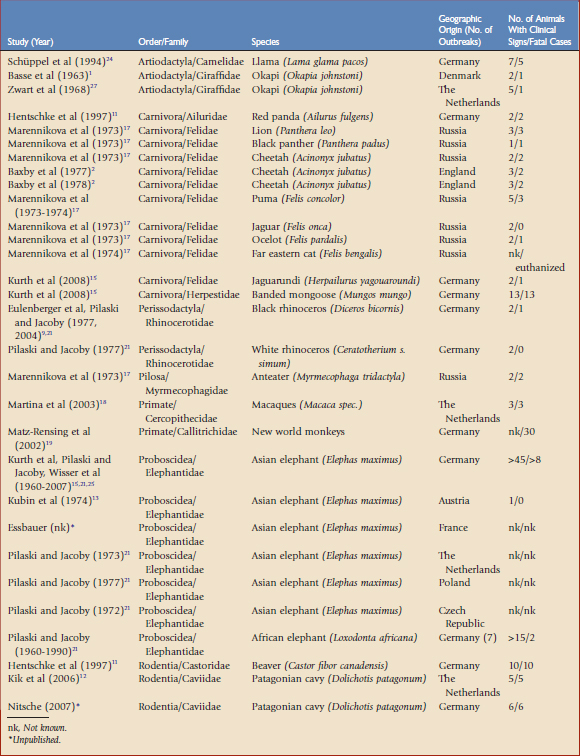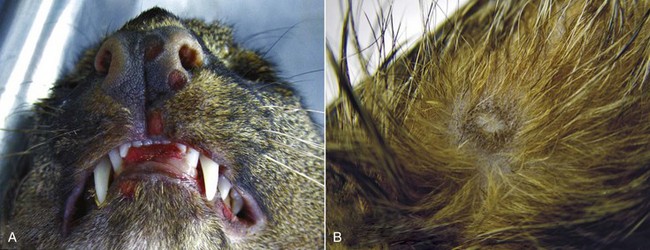Chapter 5 Cowpox in Zoo Animals
Cause
Cowpox virus (CPXV) belongs to the genus Orthopoxvirus (OPV) of the family Poxviridae. Virions are enveloped with a high tenacity, appear brick-shaped, have a size of approximately 200 nm in diameter and 350 nm in length, and carry their genomes of approximately 230 kbp in single, linear, double-stranded segments of DNA.10 Other members of the OPV are important pathogens in veterinary and human medicine, including monkeypox, vaccinia, and camelpox virus and, with lesser importance, raccoon pox, skunk pox, and vole pox virus. The different species of OPV are serologically indistinguishable from each other. Although taxonomically classified as cowpox virus, the terms elephantpox, catpox, and ratpox virus are used synonymously in the scientific community, depending on the animal species from which the respective virus was isolated.
History
Attention was first drawn to poxviruses infecting exotic zoo animals in 1960, still in the era of smallpox vaccination, when two captive Asian elephants died at the Zoological Garden in Leipzig, Germany.22 At that time, the causative agent was believed to be vaccinia virus (VACV) that had most probably been transmitted to the elephants by recently vaccinated children. However, this hypothesis was never verified. The fact that mandatory smallpox vaccination was abolished in Europe in 1980, with poxvirus outbreaks still occurring in continental European and British zoos and circuses, argues against VACV as the causative agent. To date, more than 30 such outbreaks have been reported, affecting various species (Table 5-1). Virus isolates obtained from these animals have been retrospectively characterized as CPXV. Several often fatal infections in zoo and circus elephants have been reported mainly from Germany (see Table 5-1).
Epidemiology
CPXV are endemic in Europe and western parts of Russia10 and naturally infect a broad range of host species, including domestic animals (cats and pet rats) and zoo animals, as well as humans. Interestingly, cowpox is not enzootic in cattle. Instead, cattle, like humans, are merely incidental hosts of CPXV. Almost 50 years after CPXV was first detected in a species other than cattle, new CPXV hosts are still being discovered and reported, and serologic studies have determined more wild and exotic animals that are potentially susceptible to CPXV. Elephants are the most frequently infected exotic animals. Over 60 cases of elephantpox virus infections have been reported from Germany. Therefore, today, most elephants are regularly vaccinated with vaccinia virus, which provides reliable protection against OPV infections. Hence, only sporadic cases still occur in unvaccinated elephants. The second most frequently infected group are exotic felids, with CPXV outbreaks being reported from the United Kingdom, continental Europe, and Russia. In general, exotic zoo animals that are housed in close proximity to other zoo animals and come into direct contact with wild rodents and animal keepers are likely to have a higher risk of acquiring a CPXV infection. Such circumstances were key factors for larger outbreaks involving animals of different species in Moscow in 1973-1974, Berlin in 1997, Almere, The Netherlands, in 2003, and Krefeld, Germany, in 2008.11,15,17,18 An intraspecies transmission could be observed repeatedly, with varying clinical symptoms, indicating different virus susceptibilities among vertebrates that possibly depend on the specific CPXV strain. Nevertheless, despite the wide host range of CPXV, only few infections of different animal species have been reported to be caused by the same CPXV strain. Similarly, conclusive evidence for the cocirculation of different CPXV strains within the same geographic region has only rarely been provided.4
A definite source of infection has only occasionally been identified. Although serologic surveys have demonstrated a high proportion of seropositive bank voles (Clethrionomys glareolus), field voles (Microtus agrestis), and wood mice (Apodemus sylvaticus),3,5,7,15,20,23 no CPXV isolate has been obtained from these species so far. Because mice have never been found to be CPXV-positive, both wild rats16,18 and white rats bred as food for carnivores15,17 have to be considered the most likely source in transmitting a CPXV infection to exotic animals. In this respect, the role of rats remains to be elucidated. Rats could be either a primary reservoir or an amplifying host. However, in most reports, it is only speculated that the source of infection are wild rodents, particularly mice, as they are believed to be the main reservoir for CPXV.
Pathogenesis
The clinical picture of CPXV infection in different animals is rather similar, regardless of the infected species, and mostly results in localized or multiple lesions on the skin (Fig. 5-1) and mucous membranes (Fig. 5-2). Less often, animals suffer from pulmonary symptoms without skin lesions or from a generalized rash (Fig. 5-3). CPXV infections are epitheliotropic, often starting as vesicular lesions and then developing into a pustule with an indented center and a raised erythematous border. This may be followed by a secondary bacterial infection. On the cellular level, CPXV infections result in the production of strongly eosinophilic A–type inclusion bodies in the cytoplasm of infected cells. The mortality among exotic animals and felids is high, although in most reports exact data are lacking.
Stay updated, free articles. Join our Telegram channel

Full access? Get Clinical Tree




